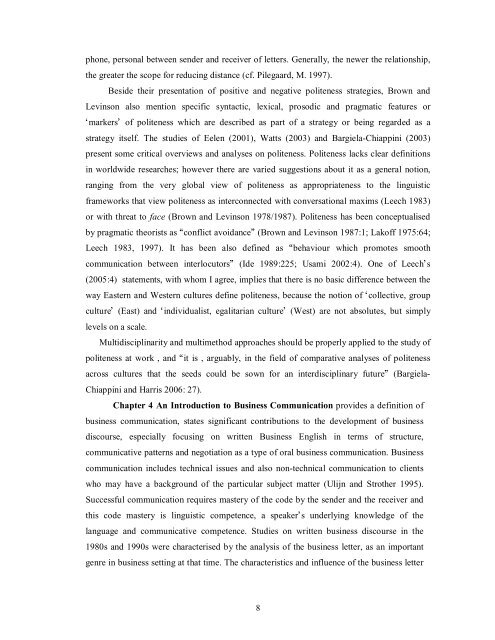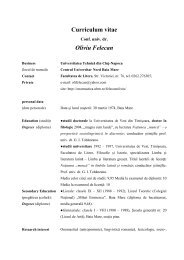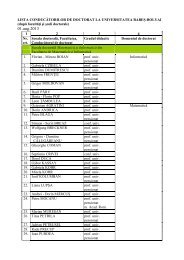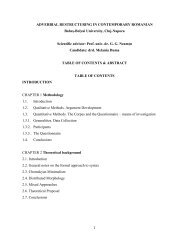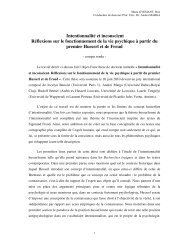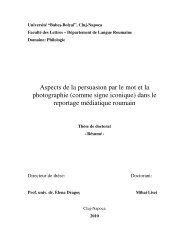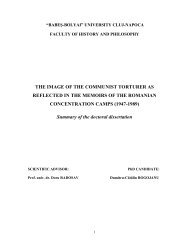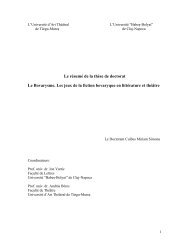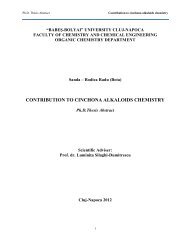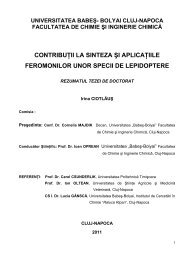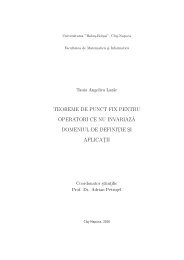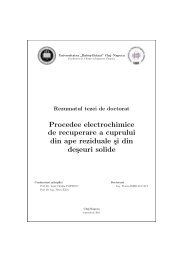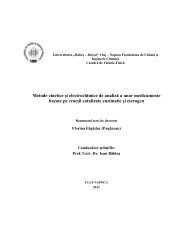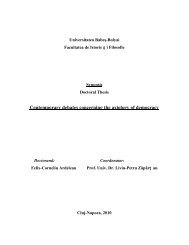1 UNIVERSITATEA “BABES –BOLYAI” CLUJ-NAPOCA ...
1 UNIVERSITATEA “BABES –BOLYAI” CLUJ-NAPOCA ...
1 UNIVERSITATEA “BABES –BOLYAI” CLUJ-NAPOCA ...
You also want an ePaper? Increase the reach of your titles
YUMPU automatically turns print PDFs into web optimized ePapers that Google loves.
phone, personal between sender and receiver of letters. Generally, the newer the relationship,<br />
the greater the scope for reducing distance (cf. Pilegaard, M. 1997).<br />
Beside their presentation of positive and negative politeness strategies, Brown and<br />
Levinson also mention specific syntactic, lexical, prosodic and pragmatic features or<br />
markers of politeness which are described as part of a strategy or being regarded as a<br />
strategy itself. The studies of Eelen (2001), Watts (2003) and Bargiela-Chiappini (2003)<br />
present some critical overviews and analyses on politeness. Politeness lacks clear definitions<br />
in worldwide researches; however there are varied suggestions about it as a general notion,<br />
ranging from the very global view of politeness as appropriateness to the linguistic<br />
frameworks that view politeness as interconnected with conversational maxims (Leech 1983)<br />
or with threat to face (Brown and Levinson 1978/1987). Politeness has been conceptualised<br />
by pragmatic theorists as conflict avoidance (Brown and Levinson 1987:1; Lakoff 1975:64;<br />
Leech 1983, 1997). It has been also defined as behaviour which promotes smooth<br />
communication between interlocutors (Ide 1989:225; Usami 2002:4). One of Leechs<br />
(2005:4) statements, with whom I agree, implies that there is no basic difference between the<br />
way Eastern and Western cultures define politeness, because the notion of collective, group<br />
culture (East) and individualist, egalitarian culture (West) are not absolutes, but simply<br />
levels on a scale.<br />
Multidisciplinarity and multimethod approaches should be properly applied to the study of<br />
politeness at work , and it is , arguably, in the field of comparative analyses of politeness<br />
across cultures that the seeds could be sown for an interdisciplinary future (Bargiela-<br />
Chiappini and Harris 2006: 27).<br />
Chapter 4 An Introduction to Business Communication provides a definition of<br />
business communication, states significant contributions to the development of business<br />
discourse, especially focusing on written Business English in terms of structure,<br />
communicative patterns and negotiation as a type of oral business communication. Business<br />
communication includes technical issues and also non-technical communication to clients<br />
who may have a background of the particular subject matter (Ulijn and Strother 1995).<br />
Successful communication requires mastery of the code by the sender and the receiver and<br />
this code mastery is linguistic competence, a speakers underlying knowledge of the<br />
language and communicative competence. Studies on written business discourse in the<br />
1980s and 1990s were characterised by the analysis of the business letter, as an important<br />
genre in business setting at that time. The characteristics and influence of the business letter<br />
8


